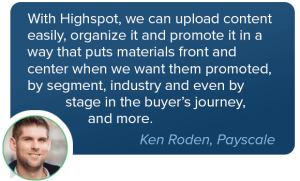As the leader in sales enablement technology, Highspot is dedicated to improving the effectiveness of sales reps. Today we are introducing a new chapter in this pursuit, the Sales Enablement Pro blog series.
The Sales Enablement Pro Series is designed to convey insights from sales enablement experts. These are forward-thinking leaders whose job depends upon connecting the dots between marketing and sales and ensuring the best available content is in the hands of those who need it.
Our series will showcase the practical application of not only sales enablement technology, but also the strategies and tactics for achieving higher sales conversions. We hope you find these conversations useful in the quest to optimize your own sales enablement goals.
Today’s conversation is with Ken Roden. Ken is a senior product marketing manager at Payscale who is responsible for sales enablement. As he points out, sales enablement has become an important catalyst for improved productivity and results.
We think you’ll enjoy Ken’s perspective.
First of all, why don’t you tell us why PayScale implemented a sales enablement solution?
Sure, to set the stage, PayScale is the largest database of salary profiles in the US and Canada. Two years ago, the company had some alarming problems when it came to its sales funnel. Most notably, sales reps just couldn’t find the tools they needed. They were using shared folders, Google Chat and Google Drive, and even Facebook to send attachments to prospects. And, they were also making their own content, which isn’t good for branding or productivity.
Sales Management was concerned about productivity because their pipeline wasn’t flowing smoothly. Marketing was frustrated because their content wasn’t being used, and they thought sales wasn’t levering what they were bringing to the table.
This sounds like a pretty normal problem to me—it’s very relatable if you talk to marketers in just about any company.
It definitely is, but it’s just not productive. We knew there had to be a better way, but no one had taken the initiative to figure it out, and that’s when sales enablement landed in my purview.
After a lot of research and investigating multiple solutions, we decided to implement Highspot because of a few reasons. First of all, we liked the sleek, really user-friendly application, and the integration into Salesforce was critical. Beyond that, it also gave us more insights into collateral usage and gave our sales reps more insights into how content was performing with prospects. Importantly, it also gave us the knowledge to see how content was performing overall so that marketing could pivot what they were making for sales.
What do you think is the most valuable aspect of using the Highspot solution?
The great thing is when a rep pitches something from Highspot, it’s embedded in Salesforce so marketing can see how long the prospect spent looking at each slide or piece of content.
Marketing can look at slides with multiple versions—sales reps are always changing slides—and see which are performing the best so we can optimize the master deck.
Holistically speaking, marketing and sales management can look at performance across different assets and see what’s used most, the level of client engagement, who uses what and how, and even how often.
What were some challenges you faced when trying to sell-in sales enablement across the company?
As the (Dilbert) saying goes, “Change is good, but you go first.” That was definitely a perception we had to overcome during the sell-in. PayScale had tried to implement sales enablement once before and failed.
The critical element was that Highspot gave us the ability to build our own ecosystem in the demo environment so we could actually prove to all the stakeholders how it would work. We had six different stakeholder groups, so it was a bit of a process to get everyone on board, but it became easier as they started to understand just how fast Highspot was to set up. We created an action plan for implementation and then got buy off one-by-one.
But stakeholder buy-off and implementation are different things, so how did implementation go?
That’s true. Once we had buy-off, we had to roll it out to the end users.
We set up in-person trainings and a grass-roots incentive plan. We encouraged sales to pitch through Highspot, and proactively gave out $100 gift cards when we saw sales using the platform, but we didn’t announce the giveaways. We let word-of-mouth take over and this helped drive organic engagement with the platform. Before long, sales saw how much better the process was in Highspot—how they could find everything they needed in one place—and adoption was no longer a concern.
It’s been about a year since you rolled out Highspot. How is it going now?
Now, sales goes to Highspot first. They know that if it’s not in Highspot they can’t get the analytics they want or alerts on how well the materials work. The adoption rate is excellent – 100% of the sales team is using Highspot.
In fact, I just got an email last week from a sales rep that said: “Finding new stuff is where Highspot is really beneficial – it’s great to see new content in the ‘featured content’ section on the home page.”
So this sounds really beneficial from a sales perspective, but how does it impact your role in marketing?
This is where I get passionate. As a marketing team, we can upload content easily, organize it and promote it in a way that puts materials front and center when we want them promoted, by segment, industry and even by stage in the buyer’s journey, and more. That’s all really great.
But, the bigger impact has been in our Quarterly Business Reviews—QBRs. This is where marketing gets the greatest value out of Highspot. The data out of Highspot enables us to build executive-level insights that show exactly how marketing contributes to the bottom line via sales success. It’s a game changer because Highspot doesn’t just shoot out a bunch of metrics. It actually applies context to the data so we can understand how both sales and prospects are interacting with our content and tools.
One last area that marketing sees benefit is the ability to use data to lead conversations. We’ve been able to refocus marketing—all twenty of us—around where we need to put our expertise because we no longer waste time building materials sales will never use. Being able to deploy and test content before committing to a full Bill of Materials is also a significant time saver.
How do you think your sales and marketing teams work together now, post-deployment?
No question, sales and marketing are better aligned now. We were just like any other company. So often, sales asks marketing for a lot of content without much context, and marketing delivers what they “think” is needed, but it isn’t what sales wanted or needed. It can be a vicious cycle. Now, we have a more streamlined path to content development, and it’s much more manageable.
Additionally, we know that the consistent sales performers—those that hit quota between 85%-105%—use Highspot. So, we can guide lower performers and help them improve through sales enablement, which helps reinforce using the platform and improves our branding and messaging consistency.
As we run short on time, what’s your biggest takeaway from implementing sales enablement? What would you tell others in your shoes?
There are a few key learnings I would tell anyone about to embark on a rollout of a sales enablement platform:
- Think creatively to ensure adoption. Our grass-roots incentive plan worked really well. Think about your sales team and what will resonate with them, and then make adoption fun.
- Continue to evangelize. Your evangelism role isn’t done when the platform is deployed. This is a constant drumbeat that should be iterated for as long as it takes, especially if you have a lot of turnover in your sales team.
- Overshare. You’ll have an amazing amount of analytics at your fingertips. Be sure to use it and share with the decision makers in your organization. It will help build trust in your decision-making, and show value of the investment you’ve made in sales enablement.
I hope you found this interview with Ken helpful. If you want to read more about companies’ success with sales enablement, check out our Highspot success stories.


